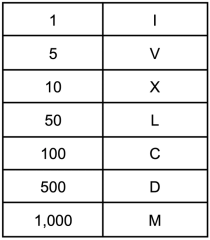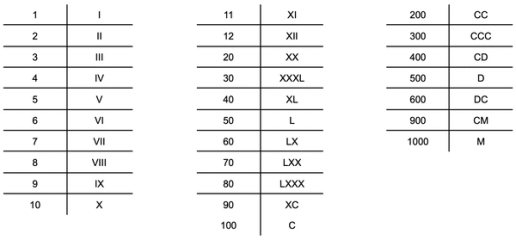Your math tutor here! Let’s dive into Roman numerals. Used widely until the 14th century, this number system was a go-to for people in Western cultures. Eventually, it was replaced by the Hindu-Arabic system, which made math and calculations much easier.
But Roman numerals are still around today!
They’re based on a set of letters—like X, V, and D—that each represent a specific number. Let’s break it down with a list of the seven key letters and their numerical values.

To get a head start on how these work, take a look at this next table - it has many common numbers that are used to convert regular numbers to Roman Numerals or vice-versa. With some help from the table above, can you identify any patterns? What rules do you think they’re using?

If you’ve gone through these tables, you might have realized what some of the rules are. If not, you will find the rules that one needs to abide by in order to write any number as a Roman Numeral successfully:
If you want a number that is a multiple of one of the 7 letters they use, its value is the sum of the value of that letter and how many times it appears. For example, III = 3 because we repeated three I’s and I is 1.
- Letters I, X, and C can be repeated a maximum of three times but not four or more. For example: XX = 20 because X = 10, so 10 + 10 = 20 = XX
- Letters L, V, D, cannot be repeated at all - they must be unique for that number.
- When you write a letter with a smaller value before a letter with a bigger value, you must subtract the smaller value from the bigger value. For example, IV is 4 because I = 1, V = 5, and since the letter I came before V, we must subtract: IV = 5 - 1 = 4.
- When you write a letter with a smaller value after a letter with a bigger value, you must add the smaller value to the bigger value. For example, LX is 60 because L = 50, X = 10, and since X is after L, we must add: LX = 50 + 10 = 60
- The letter I can be subtracted from V and X only and the letter X can only be subtracted from L, M and C.

